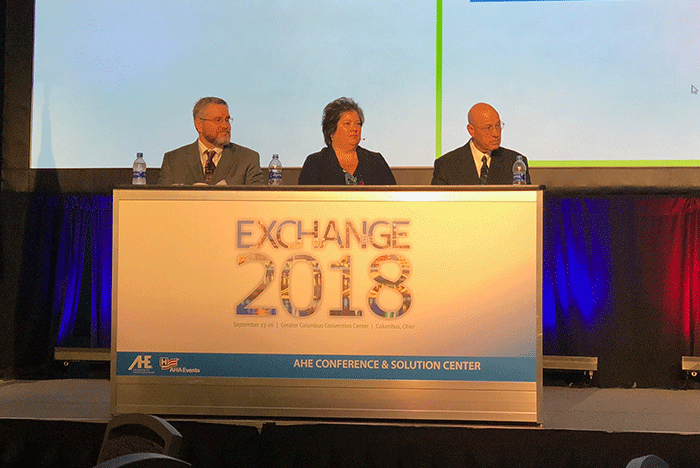AHE wraps up annual conference with sight set on the future

From left to right: Phil Hennessy, Peggy Hayden and Kenneth Kaufman discuss the transformation of health care delivery at 2018 AHE EXCHANGE Conference.
The Association for the Healthcare Environment’s (AHE) Annual EXCHANGE Conference wrapped up today in Columbus, Ohio, with three back-to-back general sessions focused on health care transformation.
Kenneth Kaufman, chair of management consulting firm Kaufman Hall, got things started this morning with a discussion on why and how legacy health care systems need to evolve to remain relevant to patients. Kaufman’s talk centered on companies such as Amazon, Apple and CVS that use technology to cross into established industries by disrupting them with innovative systems meeting customers right where they are.
Kaufman maintains that health care systems need to do the same in order to remain the dominant driver of the field, and specifically for outpatient care which non-health care companies see as a viable field for disruption.
“There are no centralized actions anymore,” Kaufman says. “Amazon doesn’t dictate their system to the consumer. They develop a million options and let you pick that option instead.”
He highlighted a concept championed by Ford Motor Co. CEO James Hackett to help health care organizations strategize their futures: Operate as efficiently as possible in the now, determine what your future should look like, and develop a transition strategy to pivot into that future.
Kaufman was then joined by Peggy Hayden, DNP, RN, NEA-BC, administrative director for education, practice and research and strategic initiatives at University of Pennsylvania Medical Center Passavant, and Phil Hennessy, director of engineering, robotics, Diversey Inc. The speakers tackled the topic of transformation of health care delivery.
Hayden explained that, traditionally, health care systems have based their understanding on how to reach patients via demographics: age, education, disease type, income, etc. She says, however, that as technology continues to evolve, deciding how to reach patients based on these groupings are less relevant.
“The technological platform has really fundamentally changed who our consumers are and what drives them,” she says. “They want more information. They want to be understood. They want to partner in their health care, and they want to help drive decisions, not be subordinate to those decisions made for them. They want to stay well and stay out of the hospital.”
Hennessy says that it’s important for traditional hospitals to partner with companies in the technology industry that can help them to create the right solutions for their organizations. And once you find a solution be sure to select change agents within the hospital that can help to champion those technologies amongst staff. He also says that health systems need to be open to small failures and positive deviance to find the solutions that work best for their patients.
“You have to be open to everything,” he says. “You need to be open and not just say we’re a cleaning company or a hospital. It’s really about looking at who we are and how we’re providing those services.”
Catch up on Day 1 and Day 2 of our coverage of the AHE EXCHANGE Conference.


